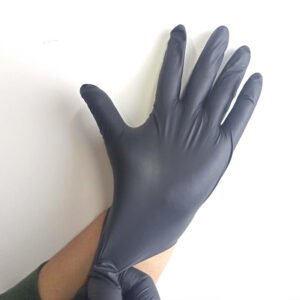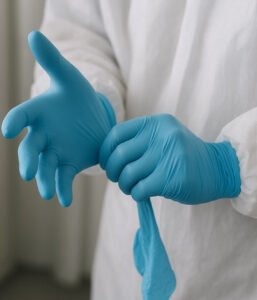What Type of Glove is Most Common in Healthcare?
Table of Contents
Introduction
In healthcare settings, personal protective equipment plays a crucial role in maintaining safety and hygiene standards. Among all protective gear, gloves are perhaps the most frequently used item, serving as the first line of defense against cross-contamination and exposure to bodily fluids. Understanding which type of glove is most common in healthcare and why it has become the industry standard can help medical facilities make informed purchasing decisions and ensure optimal protection for both healthcare workers and patients.
Nitrile Gloves: The Most Common Choice
Nitrile gloves have become the most common type of glove used in healthcare settings today. Made from synthetic rubber (acrylonitrile-butadiene rubber), these gloves have steadily replaced latex gloves as the industry standard over the past two decades. According to industry estimates, nitrile gloves now account for approximately 60-70% of all medical gloves used in healthcare facilities worldwide.
The rise of nitrile gloves represents a significant shift in medical practice. While latex gloves dominated the market throughout the 1980s and 1990s, growing concerns about latex allergies and the superior properties of nitrile materials have driven this transformation. Today, most hospitals, clinics, dental offices, and other healthcare facilities stock nitrile gloves as their primary choice for medical examinations, procedures, and general patient care.

Why Nitrile Gloves Dominate Healthcare
Several key factors have contributed to nitrile gloves becoming the most common choice in healthcare environments. First and foremost is the allergy issue. Latex allergies affect approximately 1-6% of the general population and up to 12% of healthcare workers who have repeated exposure to latex products. Nitrile gloves eliminate this risk entirely, as they contain no natural rubber latex proteins that trigger allergic reactions.
Superior puncture resistance is another critical advantage. Nitrile gloves are significantly more resistant to punctures, tears, and chemical exposure compared to latex or vinyl alternatives. This durability is essential in healthcare settings where sharp instruments are common and where gloves may come into contact with various chemicals and disinfectants. Studies have shown that nitrile gloves are up to three times more puncture-resistant than natural rubber latex gloves of similar thickness.
The material also offers excellent tactile sensitivity, which is crucial for medical professionals who need to perform delicate procedures or examinations. Modern manufacturing techniques have produced nitrile gloves that closely match or even exceed the comfort and dexterity of traditional latex gloves, while providing superior protection.
Other Types of Healthcare Gloves
While nitrile gloves are most common, healthcare facilities also use other types of gloves for specific purposes. Latex gloves, despite the allergy concerns, are still used in certain settings where their elasticity and comfort are paramount, particularly in surgical procedures. These gloves offer excellent fit and tactile sensitivity, though their use continues to decline.
Vinyl gloves represent the most economical option and are commonly used for low-risk, short-duration tasks where barrier protection is needed but the risk of exposure to infectious materials is minimal. These gloves are popular in food service areas of hospitals and for basic care tasks, though they offer less protection than nitrile or latex options.
Polyethylene gloves are thin, loose-fitting gloves used primarily for food handling and basic hygiene tasks. While not suitable for medical examinations or procedures, they serve a purpose in healthcare kitchens and cafeterias. Neoprene and polyisoprene gloves occupy smaller market niches, with neoprene offering chemical resistance for laboratory work and polyisoprene providing a latex-free alternative with similar properties to natural rubber.
Factors in Glove Selection
Healthcare facilities consider multiple factors when selecting gloves for their operations. Risk assessment is paramount—the level of protection required depends on the specific task, potential exposure to bloodborne pathogens, and the types of chemicals or medications being handled. High-risk procedures demand higher-quality gloves with superior barrier protection.
Cost considerations play a significant role, especially for facilities that use thousands of gloves daily. While nitrile gloves are generally more expensive than vinyl options, their superior protection and durability often justify the additional cost. Many facilities conduct cost-benefit analyses that factor in not just the purchase price but also the potential costs of occupational exposures and infections.
Comfort and fit are essential for compliance and effectiveness. Healthcare workers who find gloves uncomfortable or poorly fitting may be less likely to wear them consistently or may change them less frequently than recommended. Modern nitrile gloves are available in multiple sizes and thicknesses to accommodate various hand sizes and preferences, with textured surfaces for improved grip.
Future Trends in Healthcare Gloves
The healthcare glove industry continues to evolve with emerging technologies and environmental concerns. Sustainable and biodegradable nitrile gloves are being developed to address the massive amount of medical waste generated by disposable gloves. Some manufacturers are exploring plant-based additives that accelerate the breakdown of nitrile materials in landfills without compromising their protective properties during use.
Smart glove technology is another frontier, with researchers developing gloves embedded with sensors that can detect punctures or contamination in real-time, alerting healthcare workers to potential breaches in protection. Antimicrobial coatings are also being incorporated into glove materials to provide an additional layer of protection against pathogen transmission.
The COVID-19 pandemic has permanently impacted glove usage patterns and procurement strategies. Healthcare facilities are now maintaining larger stockpiles and diversifying their supply chains to prevent shortages. This increased demand has also spurred innovations in manufacturing efficiency and material science.

Conclusion
Nitrile gloves have established themselves as the most common type of glove in healthcare settings, and this dominance shows no signs of waning. Their combination of allergy-free composition, superior puncture resistance, chemical resistance, and excellent tactile sensitivity makes them the optimal choice for most medical applications. While other glove types maintain their niche roles, the versatility and reliability of nitrile gloves ensure they will remain the industry standard for the foreseeable future.
As healthcare facilities continue to prioritize worker safety, patient protection, and infection control, the selection of appropriate gloves remains a critical decision. Understanding the properties and applications of different glove types enables healthcare administrators and practitioners to make informed choices that best serve their specific needs while maintaining the highest standards of care and safety.
Professional Glove Equipment Manufacturing
We are professional glove equipment manufacturers, dedicated to providing high-quality solutions for your business needs.
